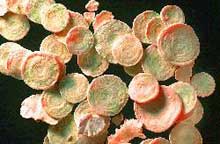This special field revolves around processes for modifying material properties (milling, cooling), composition (filtration, distillation) and type (oxidation, hydration).
Valuable information is available on a broad range of technologies including material separation, laser processes, measuring techniques and robot engineering in addition to testing methods and coating and materials analysis processes.

The same material that makes the theft detectors go off in a department store when the salesperson forgets to remove the anti-theft tag, may make inexpensive, passive temperature and stress sensors for highways, concrete buildings and other applications possible, according to Penn State researchers.
“These materials typically cost about $100 a mile and each sensor is about an inch long,” says Dr. Craig A. Grimes, associate professor of electrical engineering and member of Penn State’s

Taking their cue from fish, scientists in the US have built a navigational aid that will help robots and remote sensors find their way around the world`s vast oceans. The team describes its research today in the Institute of Physics publication Journal of Micromechanics and Microengineering.
Fish and many amphibian animals find their way through even the murkiest of waters, navigate raging torrents and spot obstacles, predators and prey using a sensory organ known as the lateral line system.

A first-of-its-kind, small-scale natural gas liquefaction facility designed by scientists at the U.S. Department of Energy’s Idaho National Engineering and Environmental Laboratory was unveiled today by Pacific Gas and Electric Company officials in Sacramento, Calif.
Other significant partners in the pioneering liquefied natural gas (LNG) facility effort include the California Energy Commission, Sacramento Air Quality Management District, SoCal Gas Company and South Coast Air Quality M

Machines not bigger than a molecule will one day surf our blood stream, search and destroy infected tissues, and heal our wounds. This is just one of the applications of nanotechnology. EU Research Commissioner Philippe Busquin will chair an information day on nanotech new frontiers in Grenoble, France, on 14 June 2002. Nanotech research is still in its start-up phase, and will be far more effective if co-ordinated and supported at EU level. The Commission will therefore allocate € 700 million to nan

Loughborough University’s Centre for Mobile Communications Research (CMCR) has made some major breakthroughs in its antenna technology that could enable safer communication for all.
Using their work associated with GPS (Global Positioning System) technology, researchers have managed to reduce emissions into the body by as much as 85%. The CMCR achieved its breakthrough in antenna designs through innovative laser technology and super computing modelling techniques. This puts the University i

Drilling for oil is expensive – and only too often unsuccessful: in 80 to 90 per cent of all attempts the drill head ends up in worthless sediment rather than hitting the black jackpot as intended. In this way, with every unsuccessful drilling, companies squander several million euros. Yet there is an alternative: the use of tiny fossilised single-celled organisms can reveal to the expert where prospecting for oil is worth while, a dying art at which only a few specialists worldwide still remain prof